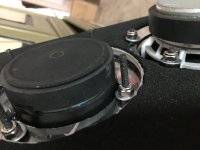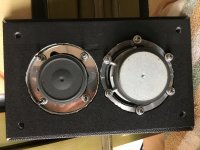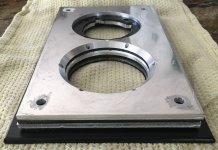Yes, that is the theory,
Something about this doesn't sit right with me. I can imagine energy transferred to the cabinet via the speaker frame as real and maybe even significant, but dominant? I don't see it. As a thought experiment - which could also be done - if we treated the panel as a DML and attached one of those tactile drivers (more or less what is being suggested above) do we expect the frequency response to be peaky and band-limited like my own measurements of the cabinet in my construction methods thread and some of those above? Or would it be more uniform and smoother, and wider bandwidth with probably a steady roll-off at high frequencies? I believe it will be the latter. The reason for the difference I suggest is that most of the SPL we measure from the cabinet is from acoustic energy of the diaphragm in the cabinet, then through the walls. Not just vibrating of the walls due to the speaker frame.
Actually, most of the spl is from the cone and then the back wave coming back through it. Panels are a variable dependent on their rigidity and more or less the source of coloration added to the response.
Yeah that would be news to me in all my years involved this is the first time hearing that the dominant cause of panel resonance is the motor not the box pressure. I'm not making that statement definitively because I do not know. Just would surprise me. Is there research that supports that that I'm just not aware of. In the end if your work does prove out and you can characterize the audibility of panel resonance it would be VERY helpful to double up with accelerometer measurements to corelate your data with it. Then you could just use accelerometer data which would be so much easier.
Mechanical noise doesn't have to be dominate to be an audible problem. Many people go to the trouble of decoupling the driver from the baffle and enjoy the results.
We are finding ways to isolate these different things, and that's not a bad way to start the new year. 😀
We are finding ways to isolate these different things, and that's not a bad way to start the new year. 😀
B&W Group North America Service & Support - Reference Materials here is the "old" news. It's in the appendix of the 800D white paper PDF.Yeah that would be news to me in all my years involved this is the first time hearing that the dominant cause of panel resonance is the motor not the box pressure. I'm not making that statement definitively because I do not know. Just would surprise me. Is there research that supports that that I'm just not aware of. In the end if your work does prove out and you can characterize the audibility of panel resonance it would be VERY helpful to double up with accelerometer measurements to corelate your data with it. Then you could just use accelerometer data which would be so much easier.
Gleaned from another related thread
Yeah that would be news to me in all my years involved this is the first time hearing that the dominant cause of panel resonance is the motor not the box pressure. I'm not making that statement definitively because I do not know. Just would surprise me. Is there research that supports that that I'm just not aware of.
I linked to a plot of the size of the forces for a small sealed subwoofer on the previous page. The forces involved are straightforward to estimate if you have an interest. For most cabinets (not ones designed to be weak) at the resonant frequencies of the cabinet the forcing from the internal air pressure is small-to-negligible compared to that from the drivers. This is not the case at low frequencies in the stiffness controlled region below the resonances.
A rigidly coupled speaker excites cabinet resonances.Something about this doesn't sit right with me. I can imagine energy transferred to the cabinet via the speaker frame as real and maybe even significant, but dominant? I don't see it. As a thought experiment - which could also be done - if we treated the panel as a DML and attached one of those tactile drivers (more or less what is being suggested above) do we expect the frequency response to be peaky and band-limited like my own measurements of the cabinet in my construction methods thread and some of those above? Or would it be more uniform and smoother, and wider bandwidth with probably a steady roll-off at high frequencies? I believe it will be the latter. The reason for the difference I suggest is that most of the SPL we measure from the cabinet is from acoustic energy of the diaphragm in the cabinet, then through the walls. Not just vibrating of the walls due to the speaker frame.
A rigidly coupled speaker excites cabinet resonances.
No one is saying it doesn't. We're saying it isn't the dominant source of cabinet radiation.
Yes, he worked for KEFBTW speaker dave has worked at plenty of speaker companies but is US based and I don't think he has worked at KEF here in the UK. Andrew Jones used to work at KEF and has posted here about cabinet vibration.
I thought you were surmising the radiation would be more uniform if it was due to mechanical coupling.No one is saying it doesn't. We're saying it isn't the dominant source of cabinet radiation.
Augerpro wrote
In your excellent research
Box Construction Methods | somasonus
You showed that an undamped cabinet had multiple resonances, and these sometimes rose to a level almost as high as the direct driver radiation. Then you added various stuffing materials and tested the effect. With the more effective stuffing materials, some of those resonances were greatly reduced (-25 dB), while others were reduced by only 5 to 10 dB. I believe the big reductions were acoustic resonances which were basically eliminated by the stuffing. The other resonances were structural, so they showed a much lower level of reduction.
We know that 3/4 inch plywood and MDF have a sound attenuation of 15 dB to 25 dB (less at low frequencies, more at high frequencies), so even with a complete absense of structural resonance, we will still get sound transmission through the cabinet... and this is probably just fine, and it probably has no audible effect. The sound attenuation is going to be very uniform across the spectrum, and the speed of sound in plywood / MDF is much higher than in air, so there is no stored energy as long as there is no structural resonance.
I believe that in your experiment the acoustic resonances drove the SPL in the box up by +20 dB or more, and this showed up in the radiated sound from the cabinet. This was ordinary sound transmission, not structural resonance. When you added stuffing, you solved that problem.
The structural resonance, on the other hand, was only reduced by 5 to 10 dB. If the only force for the structural resonance was driver vibration, there would have been NO effect due to stuffing. The fact that you got 5 to 10 dB of reduction shows that some of the forcing function was acoustically transmitted, while much of it was structurally transmitted.
When I said that the dominant driver for cabinet resonance is driver vibration, not acoustic energy in the cabinet, I should have said that I am assuming we have a well-stuffed cabinet that has no significant acoustic resonances. In this case, structural resonance is the only ones that remain, and these are primarily excited by driver vibration. But not entirely, as you have shown in your excellent study.
Yet another reason why I like the Remlab approach. It encompasses both acoustic and driver vibration as cabinet excitation.
J.
Something about this doesn't sit right with me. I can imagine energy transferred to the cabinet via the speaker frame as real and maybe even significant, but dominant? I don't see it.
In your excellent research
Box Construction Methods | somasonus
You showed that an undamped cabinet had multiple resonances, and these sometimes rose to a level almost as high as the direct driver radiation. Then you added various stuffing materials and tested the effect. With the more effective stuffing materials, some of those resonances were greatly reduced (-25 dB), while others were reduced by only 5 to 10 dB. I believe the big reductions were acoustic resonances which were basically eliminated by the stuffing. The other resonances were structural, so they showed a much lower level of reduction.
We know that 3/4 inch plywood and MDF have a sound attenuation of 15 dB to 25 dB (less at low frequencies, more at high frequencies), so even with a complete absense of structural resonance, we will still get sound transmission through the cabinet... and this is probably just fine, and it probably has no audible effect. The sound attenuation is going to be very uniform across the spectrum, and the speed of sound in plywood / MDF is much higher than in air, so there is no stored energy as long as there is no structural resonance.
I believe that in your experiment the acoustic resonances drove the SPL in the box up by +20 dB or more, and this showed up in the radiated sound from the cabinet. This was ordinary sound transmission, not structural resonance. When you added stuffing, you solved that problem.
The structural resonance, on the other hand, was only reduced by 5 to 10 dB. If the only force for the structural resonance was driver vibration, there would have been NO effect due to stuffing. The fact that you got 5 to 10 dB of reduction shows that some of the forcing function was acoustically transmitted, while much of it was structurally transmitted.
When I said that the dominant driver for cabinet resonance is driver vibration, not acoustic energy in the cabinet, I should have said that I am assuming we have a well-stuffed cabinet that has no significant acoustic resonances. In this case, structural resonance is the only ones that remain, and these are primarily excited by driver vibration. But not entirely, as you have shown in your excellent study.
Yet another reason why I like the Remlab approach. It encompasses both acoustic and driver vibration as cabinet excitation.
J.
In another thread ( Softly coupling a driver to the cabinet - full range ) jjasniew mentioned using an automatic center punch to replicate the knuckle test, I find this an interesting idea as it's a very simple way to accurately put the same amount of energy into the cabinet and measure the results, possibly with just a db meter or with a mic and laptop.
This test seems to suggest it is. http://www.linkwitzlab.com/Driver Decoupling.docNo one is saying it doesn't. We're saying it isn't the dominant source of cabinet radiation.
Ah Very good. that was basically what I was asking is there evidence of this. The data does show that the motor excites the cabinet vibrations clearly. So the next question is how do you couple the driver to the baffle in a acoustic suspension design and get a good seal. Thick compliant full perimeter gasket with screws isolated with rubber washers? There would have to be no screw contact with the frame.
I've used tension springs to hold the front baffle on ( against a soft gasket ) on four pairs of speakers, all work quite well.
hifijim> a reminder that those two tests aren't exactly apples to apples. For the fill/lining test the mic was aimed at a dummy woofer, while for the cabinet material tests it was aimed at the side and rear panels, and there was no dummy woofer mounted. There wasn't even a hole for it as I did the fill/lining tests last. I was measuring two different phenomenon: sound re-emitted through the driver daiphragm, and sound radiated by the box itself. I still need to do the test where I measure the side and rear panel of a (solid) box lined with wool.
scott> I agree that paper does suggest that, in fact a couple years ago when I started developing the idea to do these tests I read that paper and bought those grommets. Haven't done that test yet but thanks for reminding me! But if I had to nitpic the paper, he doesn't do the test where he measures the same thing but with a filled/lined box and coupled driver, so he can't really say mechanical is dominant. Mechanical certainly looks bad, but without measuring the alternative method how does he know it's worse?
It does make me wonder though if, all else equal, the neo version of a driver may better than ferrite if the bad behavior is thereby raised higher than the passband of the driver.
scott> I agree that paper does suggest that, in fact a couple years ago when I started developing the idea to do these tests I read that paper and bought those grommets. Haven't done that test yet but thanks for reminding me! But if I had to nitpic the paper, he doesn't do the test where he measures the same thing but with a filled/lined box and coupled driver, so he can't really say mechanical is dominant. Mechanical certainly looks bad, but without measuring the alternative method how does he know it's worse?
It does make me wonder though if, all else equal, the neo version of a driver may better than ferrite if the bad behavior is thereby raised higher than the passband of the driver.
Last edited:
Everything is decoupled from everything, “rubber grommets” included. The baffle by itself also weighs 9lbs, compared to the original 1" mdf baffle that weighs 1.5lbs by itself.
Attachments
Last edited:
Not only SL came with driver decoupling, KEF did too. Even their CS kit drivers like the B110B were provided with a thick gasket and soft rubber washers. This all was about 35-40 years ago. And IIRC the 104.2 has been mentioned here before. Anyone noticed the effort put in driver decoupling in those designs?
- Home
- Loudspeakers
- Multi-Way
- Accelerometers to measure panel vibrations?


